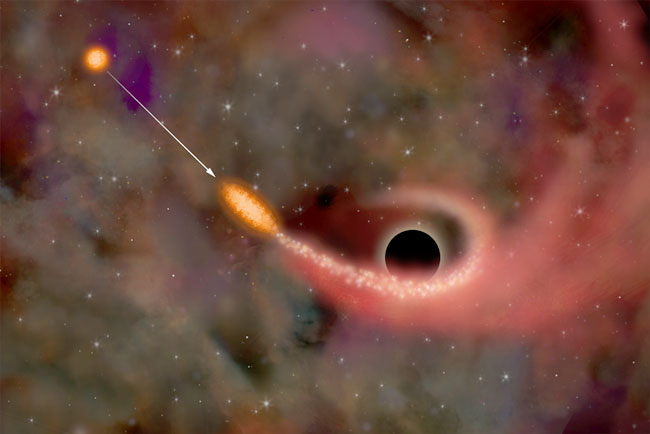
|
Explanation: What could rip a star apart? A black hole. Giant black holes in just the right mass range would pull on the front of a closely passing star much more strongly than on the back. Such a strong tidal force would stretch out a star and likely cause some of the star's gasses to fall into the black hole. The infalling gas has been predicted to emit just the same blast of X-rays that have recently been seen in the center of galaxy RX J1242-11. Above, an artist's illustration depicts the sequence of destruction (assuming that image-distorting gravitational-lens effects of the black hole are somehow turned off). Most of the stellar remains would be flung out into the galaxy. Such events are rare, occurring perhaps only one in 10,000 years for typical black holes at the center of typical galaxies.
|
January February March April May June July August September October November December |
| ||||||||||||||||||||||||||||||||||||||||||||||||
NASA Web Site Statements, Warnings, and Disclaimers
NASA Official: Jay Norris. Specific rights apply.
A service of: LHEA at NASA / GSFC
& Michigan Tech. U.
Based on Astronomy Picture
Of the Day
Publications with keywords: black hole - star
Publications with words: black hole - star
See also:
- APOD: 2025 December 3 Á Visualization: Near a Black Hole and Disk
- APOD: 2025 September 24 Á GW250114: Rotating Black Holes Collide
- APOD: 2025 June 11 Á 25 Brightest Stars in the Night Sky
- APOD: 2025 May 9 Á IXPE Explores a Black Hole Jet
- APOD: 2025 May 6 Á The Doubly Warped World of Binary Black Holes
- APOD: 2025 May 4 Á Spin up of a Supermassive Black Hole
- APOD: 2024 November 24 Á Journey to the Center of the Galaxy
